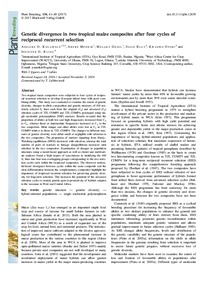| dc.contributor.author | Kolawole, A.O. |
| dc.contributor.author | Menkir, A. |
| dc.contributor.author | Gedil, M. |
| dc.contributor.author | Blay, E. |
| dc.contributor.author | Ofori, K. |
| dc.contributor.author | Kling, J.G. |
| dc.date.accessioned | 2019-12-04T11:07:47Z |
| dc.date.available | 2019-12-04T11:07:47Z |
| dc.date.issued | 2017 |
| dc.identifier.citation | Kolawole, A.O., Menkir, A., Gedil, M., Blay, E., Ofori, K. & Kling, J.G. (2017). Genetic divergence in two tropical maize composites after four cycles of reciprocal recurrent selection. Plant Breeding. |
| dc.identifier.issn | 0179-9541 |
| dc.identifier.uri | https://hdl.handle.net/20.500.12478/1587 |
| dc.description | First published: 6 January 2017; Open Access Journal |
| dc.description.abstract | Two tropical maize composites were subjected to four cycles of reciprocal recurrent selection to develop divergent inbred lines with good combining ability. This study was conducted to examine the extent of genetic diversity, changes in allele composition and genetic structure, of 100 randomly selected S1 lines each from the original (C0) and advanced (C4) selection cycles of TZL COMP3 and TZL COMP4, genotyped using single nucleotide polymorphism (SNP) markers. Results revealed that the proportion of alleles at both low and high frequencies decreased from C0 to C4, whereas those at intermediate frequencies increased at C4 in the two composites. More unique and other alleles were lost at C4 in TZL COMP3 relative to those in TZL COMP4. The changes in different measures of genetic diversity were either small or negligible with selection in the two composites. The proportion of markers departing from Hardy–Weinberg equilibrium (HWE) decreased with selection, whereas the total number of pairs of markers in linkage disequilibrium increased with selection in the two composites. Examination of changes in population structures using a model-based approach as well as cluster and multivariate analyses found a high degree of concordance in stratifying the 400 S1 lines into four non-overlapping groups corresponding to the two selection cycles each within the reciprocal composites. The observed molecular-based divergence between cycles within the same composite and the clear differentiation between the complementary composites highlight the importance of reciprocal recurrent selection for preserving genetic diversity for long-term selection. This increases the potential of the advanced selection cycles to sustain genetic gain in productivity of hybrids adapted to the savannas in West and Central Africa. |
| dc.description.sponsorship | Alliance for a Green Revolution in Africa |
| dc.format.extent | 41-49 |
| dc.language.iso | en |
| dc.subject | Maize |
| dc.subject | Genetic Variation |
| dc.subject | Hybrids |
| dc.subject | Genetic Structure |
| dc.subject | Oriented Populations |
| dc.subject | Single Nucleotide Polymorphism |
| dc.title | Genetic divergence in two tropical maize composites after four cycles of reciprocal recurrent selection |
| dc.type | Journal Article |
| dc.description.version | Peer Review |
| cg.contributor.crp | Maize |
| cg.contributor.affiliation | International Institute of Tropical Agriculture |
| cg.contributor.affiliation | University of Ghana |
| cg.contributor.affiliation | Ladoke Akintola University of Technology |
| cg.contributor.affiliation | Oregon State University |
| cg.coverage.region | Africa |
| cg.coverage.region | West Africa |
| cg.coverage.country | Nigeria |
| cg.isijournal | ISI Journal |
| cg.authorship.types | CGIAR and developing country institute |
| cg.iitasubject | Genetic Improvement |
| cg.iitasubject | Maize |
| cg.iitasubject | Plant Genetic Resources |
| cg.journal | Plant Breeding |
| cg.howpublished | Formally Published |
| cg.accessibilitystatus | Open Access |
| local.dspaceid | 82226 |
| cg.targetaudience | Scientists |
| cg.identifier.doi | https://dx.doi.org/10.1111/pbr.12439 |

